Lunging A Horse Well:
The Best Foundation For Training
Lunging a horse well is the ideal basis of all training because it develops the strength and straightness required for a horse to carry a rider without damaging effects. It is essential that the lunging is carried out in the right way for it to be beneficial.
Why Lunging?
With the rise in popularity of natural horsemanship methods where the horse is usually worked loose in a round pen, the tradition of lunging a horse as the basis for its training and preparation for ridden work has perhaps lost popularity in recent years, and even been subject to denigration. However, lunging a horse properly has certain attributes which make it gymnastically a far superior method of training to loose work.
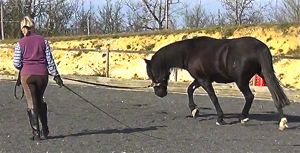
The most important advantage of lunging is that it makes it possible to work the horse on the correct bend. A horse's natural way of balancing and aligning his body through a turn is very different from what is balanced for carrying a rider. Naturally, horses bend their body against the turn - with their head and quarters bent out, and their belly falling inwards - and usually they lean into the turn in the same way as a motorbike does (as shown by the photo below).
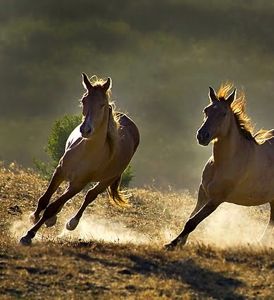
This may be an efficient way of balancing for a horse without a rider, but when a horse is under saddle this is very undesirable for several reasons:
- The misalignment of the horse's body relative to the direction of movement makes it impossible for the hind-legs to carry weight and thrust evenly. Not only is power lost, sheer forces are generated which are destabilizing for the rider.
- The misalignment inherent in bending against the circle in this way completely blocks the longitudinal stretch which is the foundation of all correct work. the longitudinal stretch is what raises the horses back like a suspension bridge, making it strong enough to carry a rider without damaging compression of the horse's spinal column.
- When the horse leans its body in on the circle ('motorbikes', as we say) the rider is unbalanced, and will usually attempt to correct themselves by putting their weight to the outside. This consolidates the lack of bend and true balance, and prevents the possibility of achieving engagement.
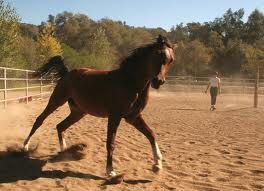
Even without a rider, a horse made to work on a circle on the wrong bend is stressing his joints and reinforcing both a hollow and a crooked posture (photo, right). A horse who is not bending correctly cannot stretch correctly either - longitudinal flexion and correct bending go hand-in-hand.
It is impossible to make a horse working loose bend correctly. Therefore this kind of work has no gymnastic value in training.
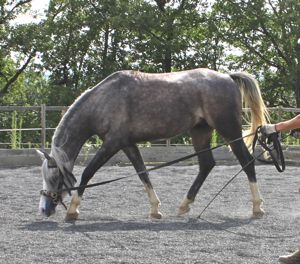
Lunging a horse allows the development of the bend through the combination of the contact in the lunge line, the whip and the handler's posture. When correctly employed, these tools can be used to sculpt the horse into the correct alignment, which initiates the longitudinal stretch, essential to engagement.
Common Problems With Lunging Technique
Lunging a horse well is an art that takes patience and application to develop. It is not easy to be able to control the horse's body and way of moving at a distance, and many people make the following errors:
- Lack of Contact
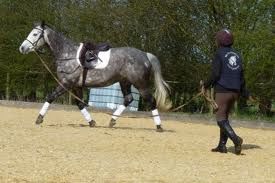 The contact in the lunge line, i.e. the steady connection between horse and handler through the line, is absolutely essential to good lunging. However it is very common to see lunging being done with a slack line (photo, left) and therefore no contact. This is because most horses naturally avoid the bending influence of the lunge line contact by falling-in on the circle, and it takes skillful use of the whip and perseverance to correct this. Lunging a horse with no contact in the line means lunging with no bend, and has no gymnastic value.
The contact in the lunge line, i.e. the steady connection between horse and handler through the line, is absolutely essential to good lunging. However it is very common to see lunging being done with a slack line (photo, left) and therefore no contact. This is because most horses naturally avoid the bending influence of the lunge line contact by falling-in on the circle, and it takes skillful use of the whip and perseverance to correct this. Lunging a horse with no contact in the line means lunging with no bend, and has no gymnastic value.
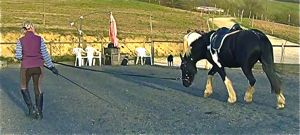
The contact also encourages the longitudinal stretch, when the horse drops his head and neck and raises the back, as it can be used to draw the horses whole body out in alignment, from the haunches right through to the head (photo, above).
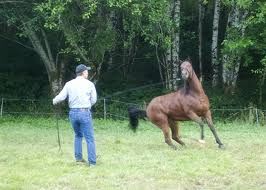 Jerking of the lunge line, whether moderately or violently, is also a misuse of the contact. If a horse is leaning or pulling the solution lies in addressing the crookedness or lack of balance that is causing the horse to lean. Like in riding, this cannot be done with an aggressive contact. Often leaning is just a symptom of postural weakness, and with time and strengthening work it will resolve itself.
Jerking of the lunge line, whether moderately or violently, is also a misuse of the contact. If a horse is leaning or pulling the solution lies in addressing the crookedness or lack of balance that is causing the horse to lean. Like in riding, this cannot be done with an aggressive contact. Often leaning is just a symptom of postural weakness, and with time and strengthening work it will resolve itself.
Lunging should ideally always be done in an enclosed area, so that if the horse should break free, he can be quickly and easily recovered.
- Using Tight Side-Reins and Other Gadgets
One of the most common mistakes people make when lunging a horse is to adjust the side-reins too short in an attempt to create a 'head-set' and make the horse 'round'. In correct work in engagement, the horse's head carriage is always a result of straightness and true longitudinal stretching; it is never something that we create artificially. Forcing a horse to work in side-reins that prevent him stretching his neck, and demand an artificial rounding is physically damaging and inhibits engagement on the ring.
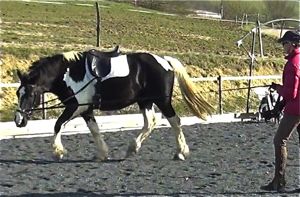
A young horse should be able to drop his nose right to the ground before he contacts the side-reins (photo, right) and in our opinion they should never be significantly shorter than this at any stage of training because the horse working on the lunge does not have the benefit of the rider's aids to create the higher degree of engagement that a short contact requires. The longitudinal stretch is the perpetual goal of all work in the lunge, because it is this that strengthens the horse in the right way to carry a rider. Tight side-reins not only prevent us from seeing whether the horse is stretching or not, they also prevent him from stretching in the right way at all.
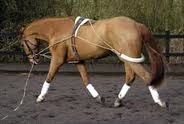
There is a huge range of gadgetry (or so-called 'auxiliary aids') available for supposedly encouraging the horse to take on the right shape on the lunge. If your horse is not stretching and lifting his back when you lunge without these artificial devices, then either your skill at aligning him onto the bend and balancing his movement needs to be improved, or your horse has a physical problem preventing him from stretching that needs to be addressed. For both these problems, resorting to quick-fix devices is not only counter-productive but damaging to your horse.
- Going Too Fast
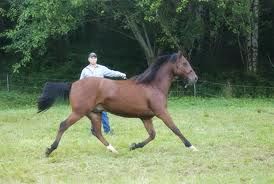
Many horses are made to rush on the lunge by aggressive use of the whip, or a simple lack of sufficient sensitivity. In order for a horse to engage his postural muscles he must slow down, in the same way that postural exercises such as yoga, pilates or body-building are done slowly. A rushing horse is perpetually falling onto the forehand, and stands no chance of learning to balance properly and carry himself in engagement. As the horse strengthens posturally, the power of the work can gradually increase without balance and engagement being lost.
- Attaching the Lunge Line to the Bit
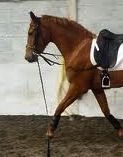
When you are lunging a horse, you have a very strong leverage over the horse, due to the fact that you are standing still on the ground at the apex of the circle, and the horse is moving around you. Applying this leverage to the horse's mouth is brutally forceful, even when it is done in the 'traditional' way of passing the line through the inner bit ring and clipping it onto the outer one.
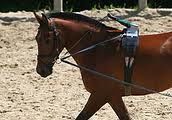
The practice of attaching the line to a D-ring on a surcingle or saddle and then passing it through the bit ring (photo, left) is even more appalling in the massive leverage that becomes available to winch the horse's neck in, effectively turning the lunge line into a kind of draw rein. This has nothing to do with beneficial lunging, because it is fundamentally blocking the horse in front and preventing the all-important telescoping forwards of the neck. When the lunge line is attached to the central ring of the cavesson on the horse's nose, it can be used both to position the horse's head in onto the bend in the right way, and to establish a leading-forwards feeling through the horse's whole body. These effects are impossible to achieve when lunging a horse off the bit.
It is also totally unsuitable to lunge a horse from a head-collar or any other kind of loose halter, because not only will you not have a good connection with the horse, but anything loose is very likely to rub or pull round into the horses eye.
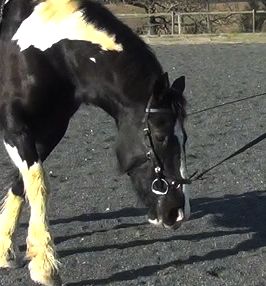
The only bridle, to our knowledge, that is suitable to lunge from is the Micklem Multibridle (photo, right) which is designed to be used for this purpose and has a D-ring set into the noseband. It is actually an excellent alternative to the lunging cavesson because its unique design means that it avoids all of the pressure-points around the cheeks and jaw.
The Uses of Lunging
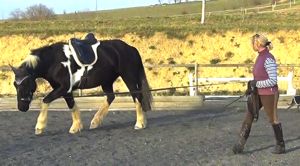
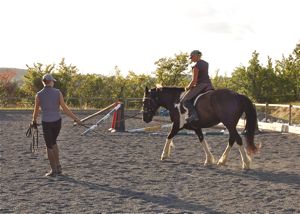 The most important use of lunging a horse is in preparation for the first ridden work of a young or un-backed horse.
The most important use of lunging a horse is in preparation for the first ridden work of a young or un-backed horse.
It is essential, before a rider ever sits on a horse's back, that it has been strengthened and prepared by good lunging over a sufficient period of time.
Work on the lunge that strengthens the horse's longitudinal stretch is crucial in order to counteract the horse's natural hollowing reflex in response to the foreign weight of a rider. It is very difficult to undo the damage done by backing a horse without any gymnastic preparation.
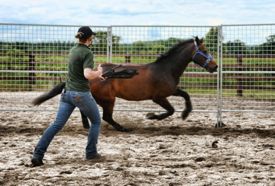
Natural horsemanship methods have promoted the idea that the faster we can take a young horse from unhandled to being sat on the better, and that if this can be done in a few hours it is somehow a great achievement. In our experience of bringing on many young horses of all types, the real gymnastic preparation on the lunge that is necessary before backing takes place rarely takes less than three months, and with some horses it may take twice as long as this before they are ready. The extra time spent lunging a horse at this stage is repaid a hundred fold in the subsequent training progression under saddle.
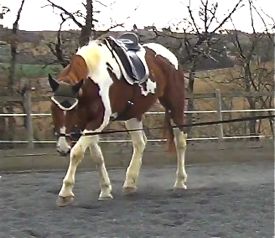
Lunging is not just useful for young horses; it is a great way of assessing and validating the work of a horse at any stage of training. Especially for remedial work, lunging a horse is a very important way of unwinding problems and re-establishing good training. It is also an excellent way of building trust.
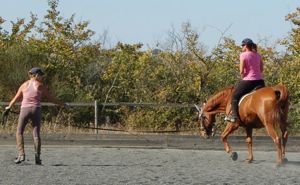
A horse that is well-trained on the lunge also has the great advantage of being suitable for use in lunge lessons, where the rider can learn the independent seat, correct posture and aiding. The greatest value of this kind of teaching is that the rider is able to learn without the reins, breaking the all too common dependence on them. A horse is only useful for this kind of teaching if he has learned to work calmly, in balance and straightness, and most importantly without being held in by tight side-reins, as this negates any understanding the pupil can gain from seeing how his body influences the horse's.
Above all, lunging a horse should never be regarded as merely a way of 'exercising' him. Lunging that is performed without care for how the horse is using himself, whether he is bending and stretching, is worse than useless in training, because not only does it reinforce crookedness and hollowness, it also stresses the horse's joints, and often his mind too.
Learning To Lunge A Horse Well
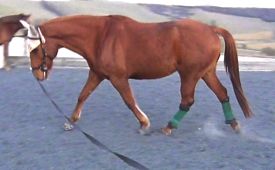
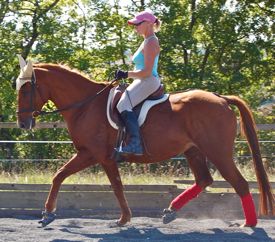
Anyone can learn to lunge well, and not only is it greatly beneficial for your horse, it is also highly instructive for the rider.
Lunging a horse towards engagement allows you to see before your eyes the dynamics at work in the horse's body, which are exactly the same when you ride.
This adds another dimension to your understanding of engagement, as you can both see in the horse and feel through the line exactly how alignment, bending, balance and engagement are all intertwined.
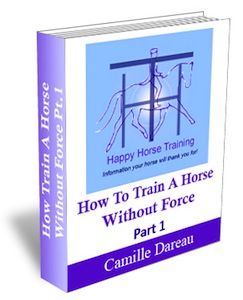
If you would like to learn how to lunge a horse in this way, HHT's e-Book How To Train A Horse Without Force Pt. 1 is an excellent in-depth guide to this and many other interactions on the ground with the horse. It explains in detail both the practical information you need to know and the training approach to get the best out of working with your horse in this way, building the trust between you. It also provides numerous exercises you can use when lunging a horse to strengthen him in the right way, with plenty of photographs to help your understanding.
Being able to lunge well is a precious tool for any horse trainer or rider, and something that you can develop and learn more from for as long as you practice it.
The pages on HHT are so wide-ranging and interrelated that we strongly recommend you look at the site plan to find other subjects that may interest you, however here are some pages directly related to Lunging A Horse Well:
Training horses: the whole way!
How To Train A Horse Without Force
Training Young Horses
Dressage and Natural Horsemanship - What's the Difference?
What is real dressage riding?
return from Lunging A Horse Well to HHT home
Enjoy this page? Please pay it forward. Here's how...
Would you prefer to share this page with others by linking to it?
- Click on the HTML link code below.
- Copy and paste it, adding a note of your own, into your blog, a Web page, forums, a blog comment,
your Facebook account, or anywhere that someone would find this page valuable.









 The contact in the lunge line, i.e. the steady connection between horse and handler through the line, is absolutely essential to good lunging. However it is very common to see lunging being done with a slack line (photo, left) and therefore no contact. This is because most horses naturally avoid the bending influence of the lunge line contact by falling-in on the circle, and it takes skillful use of the whip and perseverance to correct this. Lunging a horse with no contact in the line means lunging with no bend, and has no gymnastic value.
The contact in the lunge line, i.e. the steady connection between horse and handler through the line, is absolutely essential to good lunging. However it is very common to see lunging being done with a slack line (photo, left) and therefore no contact. This is because most horses naturally avoid the bending influence of the lunge line contact by falling-in on the circle, and it takes skillful use of the whip and perseverance to correct this. Lunging a horse with no contact in the line means lunging with no bend, and has no gymnastic value.

 Jerking of the lunge line, whether moderately or violently, is also a misuse of the contact. If a horse is leaning or pulling the solution lies in addressing the crookedness or lack of balance that is causing the horse to lean. Like in riding, this cannot be done with an aggressive contact. Often leaning is just a symptom of postural weakness, and with time and strengthening work it will resolve itself.
Jerking of the lunge line, whether moderately or violently, is also a misuse of the contact. If a horse is leaning or pulling the solution lies in addressing the crookedness or lack of balance that is causing the horse to lean. Like in riding, this cannot be done with an aggressive contact. Often leaning is just a symptom of postural weakness, and with time and strengthening work it will resolve itself. 






 The most important use of lunging a horse is in preparation for the first ridden work of a young or un-backed horse.
The most important use of lunging a horse is in preparation for the first ridden work of a young or un-backed horse. 





